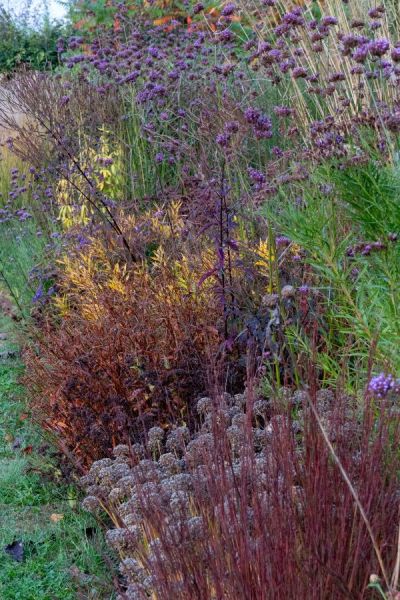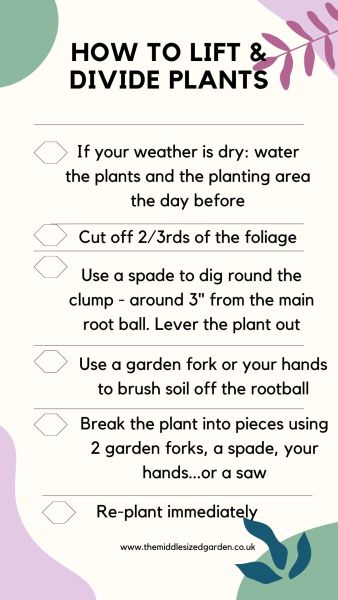Brilliant border maintenance – what to do now for next summer’s success
Garden border maintenance in both autumn and spring is mainly about the plants.
Summer and early autumn is for dead-heading. Weeding goes on all year round if you have a mild climate. Watering is for dry spells.
But in both autumn and spring, it’s time to plant new plants, move plants that are in the wrong place and divide overgrown perennials.
So I visited Steve Edney and Louise Dowle at their No Name Nursery to find out how they manage their 100ft herbaceous border at this time of year. (You can find out how they created it in What You Need to Know to Create a Stunning Perennial Border.)
Steve and Lou trial plants in this border to see how they would look together in your border. The nursery isn’t open for visitors, but you can find them at plant fairs around the South East of the UK. They also offer garden consultancy.

Essential border maintenance tips for autumn and spring.
Should you clear the border in autumn or spring?
Clearing borders in autumn used to be seen as an essential part of border maintenance. But Steve and Louise don’t clear their borders until spring.
They say there are three reasons for this. Firstly, wildlife – insects, invertebrates, small mammals and birds – will continue to enjoy seedheads and berries, and they’ll shelter amongst the foliage. ‘If you stop and listen in winter, you can hear the life rustling in the border,’ says Lou.
Secondly, many of the grasses and seedheads look beautiful in mist or frost, so you can continue to enjoy your border.
And thirdly, it’s easier! The weather or wildlife will ‘do a lot of the work for you’ if you leave it.

Steve and Louise don’t clear their borders until spring – so the wildlife will do some of the clearing up for them as the grasses and seedheads slowly disintegrate over winter. They’ve built this bug hotel, too, which covers an unsightly pump, but the slowly decaying plants in the border will be even more valuable for wildlife.
If you clear away foliage in autumn, some of it will still be green, says Steve. There will be lots of it and it’ll be hard to put through the shredder. You’ll have a lot of waste disposal to deal with.
But by spring, much of the foliage has dried or collapsed. Wildlife will have taken the seeds and berries. It’s much quicker to clear away what’s left. And as it’s dry, you can put it through the shredder to compost it, says Louise.
They then put it back on the border as a mulch, where it will break down and return nutrients to the soil.
‘I only cut something down once I can’t bear to look at it any longer,’ says Steve. So their main border maintenance in autumn is dividing, moving or replacing plants.
Why move plants?
There are two good reasons for moving plants. Firstly because they don’t look right where they are. And secondly, because they don’t grow well in that position.
Steve and Lou wanted to move a large clump of Australian bluegrass (Poa labillardierei) at the front of a border because it didn’t look right next to another grass. Visually, the two grasses detracted from each other. And the big tussock of poa was hiding other good plants in the middle of the border.
‘At the front edge of a border, you want plants that will work really hard,’ says Steve. ‘You want long-flowerers. In the middle of a border, you can build communities of plants that flower at different times, but your front edge is quite critical.’
You also need resilient plants at the front of the border, because you don’t want a plant that collapses when the weather is challenging. So they’re also going to move a Calamintha further down the front of the border that is clearly in the wrong spot.
When to move plants
The most successful times to move plants is either the autumn or the spring.
‘In the autumn, you can see where the plants are,’ says Steve. ‘And in the spring, you’ve often got emerging new growth, so you can also see where the plants are. If you try to move them in winter, you may well tread on dormant plants beneath the soil and damage them.
Experienced plant growers can also move plants in summer – Steve says that plants can grow well if moved in summer. However, if the weather is particularly dry or hot, they’ll need extra care, which is why gardening experience is usually helpful.
You’ll also find recommendations as to when to move specific plants. Many people move autumn flowering plants in the spring and spring flowering plants in the autumn.
Your weather can also be a factor – if you have very wet, cold winters and heavy soil, then you’ll probably have more success moving plants in the spring.
However, Louise quotes the late, great Christopher Lloyd, who said that the best time to do many garden jobs is when you’ve got time.

Alliums, verbena bonariensis and grasses in the No Name Nursery border all offer autumn and winter interest.
Can you move any plant?
Steve says that if a plant has been in your border for less than five years, then it’s got a good chance of surviving if you move it.
And most perennials benefit from lifting and dividing every 3-7 years – which is an ideal opportunity to move the plant.
But a tree or a woody shrub, such as a rose, that has been in your border for years is much less likely to survive a move. It would be better to propagate it if you want it in a different place.
How to plant a plant
Firstly, establish whether a plant will grow in your soil. Does it need particularly dry or damp conditions?
Is it a sun lover or does it prefer shade? Ideally, know your pH levels and whether the plant is right for them (‘A rhododendron planted on chalk is a dead plant waiting to happen,’ says Steve.)
Then Steve prepares the soil first. If it’s been dry, they will water the area where they’re going to plant the day before.
If you’re a no-dig gardener, you’ll only dig a hole the size of the rootball. Then once the plant is in the hole, you’ll replace the soil and add a layer of compost on top. You can find out more about no dig for flower gardens here.
Steve, however, does break up the soil with a spade, digging in garden compost or well rotted bark compost.
He then decides where the plant is going to go by setting it (or them) on the border in their pots. He advises keeping them about 40cm away from the border edge, to give them a chance to spread.
Steve digs a hole about twice the size of the rootball and then adds water to the bottom of the hole. This encourages roots to grow downwards.
‘If the weather has been dry, then watering at the top once the plant is planted often only penetrates the top few inches of soil,’ he says. ‘So the roots will often grow upwards in search of that moisture.’
Steve likes to bury the label in the hole before planting the plant. Plant labels often fade in the sun or get lost if they’re just sticking out of the earth.
Adapt your planting to local conditions
It’s worth thinking about how your climate and soil could affect the way you plant plants, says Steve.
If you have a dry climate, then plant plants a little deeper than the level of the earth, so that water doesn’t run away.
If you have a wet climate or heavy soil, plant plants in a slightly raised position so they’ll drain better.
Once you’ve got the plant positioned the way you want it, fill the rest of the hole with your soil or soil and compost mix. ‘Firm it in with your hands,’ says Steve.
Essential border maintenance – lift and divide older perennials
Many perennials need dividing every three or four years. The clumps get too large, and there is often a bare patch in the middle where the original root has died off.
Lifting and dividing plants is an essential part of good border maintenance. You can do it in autumn or spring. Louise showed me how.
Preparing to divide plants
Louise advises watering plants thoroughly a day or so before you’re going to lift and divide them.
If you’ve had lots of rain, you don’t need to bother with this, but in dry weather, watering before you dig plants up will make the job easier.
Then she starts by cutting off the top two-thirds of the foliage. It makes the plant easier to work with.
However, she advises leaving at least enough on the plant so you can handle it when it’s out of the ground.
Dig the plant up
Lou dug around the plant with a sharp spade to loosen it. ‘I’m digging around 3″ away from the main root of the plant,’ she says. ‘Day lilies have quite fleshy roots and if I cut into them, it won’t cause much damage.
But if you have plants with a larger, more woody root, then you could damage the roots by cutting too close, so dig into the soil around 6″ away.’
It may take you a while to work your way around the plant, jamming the spade down into the earth and using a foot to wedge it down further, then easing the plant out.
‘It’s impossible to get right to the bottom of a plant without severing any roots,’ she says.
Then knock the soil off from around the roots with a fork, working round the plant to get as much soil off as possible.
You’ll be able to see the roots more clearly and ‘where’s there’s a natural division,’ says Lou.
Breaking the plant into pieces
You can decide how many pieces you want from the plant. Some plants – such as the day lilies Lou dug up – can be broken up into lots of tiny individual plants.
If they’re very small, Lou suggests putting them into pots until they’re large enough to deal with the competition from the rest of the border.
You can pull some clumps of plants apart with your hands.
Otherwise, Lou uses two forks back-to-back. She wedges one fork right down into the plant clump. And then she wedges a second fork in, so that the backs of the two forks are touching.
Then she levers the outer fork away from the other, with the fork handle moving away from the other fork while the base of the two forks stay together until the last moment.
(I personally have never succeeded in using two forks back-to-back and now think that’s because I didn’t lever the second fork away, I tried to tug it.)
‘As pieces get smaller, you can do the same thing with hand forks,’ says Louise.
And if the plant is really stubborn, many people will even use a saw. ‘There’s no real science to it,’ Lou says. ‘Just get stuck in.’
After you’ve split the plants, cut back their foliage to a few inches above the ground.
Which plants to divide in autumn and which in spring
Louise advises splitting grasses in spring, but most other perennials in autumn.
Some gardeners advise splitting autumn flowering perennials in spring and spring flowering perennials in autumn.
Steve says that you shouldn’t move or divide a plant while it’s actually flowering, because it’s putting all its effort into making flowers, so it will be harder for it to establish.
But otherwise experienced gardeners will move plants at any time – professionals have to work throughout the year.
Replant immediately after lifting and dividing
Once you’ve divided your plant up, re-plant it in the soil or in pots as soon as possible.

More about creating beautiful borders
Steve and Louise share their tips on creating their long border in What You Need to Know to Create a Stunning Perennial Border.
And head gardener and garden writer Tom Brown shares 12 essential tips for stunning garden borders here.
Rosy Hardy of the award-winning nursery, Hardy’s Cottage Garden Plants and the Rosy Hardy YouTube channel explains how to choose the right perennials for a border in Perennials Made Simple.
And Henry Macaulay of the top perennial nursery Marchants explains more about filling gaps in your border here.
You can find Steve and Louise at plant fairs around the UK, along with many other brilliant independent nurseries. The Plant Fairs Roadshow is a collective of these nurseries – find their tips on top autumn plants for your border here.
Pin to remember border maintenance for autumn and spring
And do join us – see here for a free weekly email with more gardening tips, ideas and inspiration.

























I shall treasure the advice passed on from Christopher Lloyd, as undergardener in this household I thank you!
Me too!
I have to plan in advance as anything I intend to in the Autumn its spring the time I get around to it as not have much spare time around work.